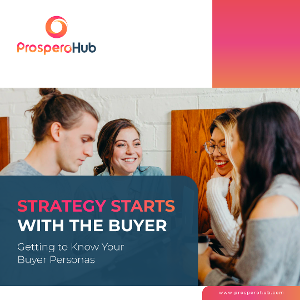We have been sharing our insights into what digital transformation means for sales and marketing B2B professionals, how they target prospects and how technology provides opportunities for greater competitive advantage. Digital transformation can make your sales and marketing strategy easier to implement through automation tools, but it can’t tell you who to target or what your message to them should be. The capabilities of digital technology in sales and marketing are vast and wide but to make it effective in adding growth value to your business, you need a strategy. Where do you begin?
Creating an Effective Sales & Marketing Strategy
To create an effective content marketing strategy, you must start with the thing that will create growth for your business. Obviously, this is your prospect turning into a customer, so your sales and marketing strategy must be built around them. Social selling, applying the information available in social channels to aid the sales pursuits, is a lucrative element of the power of social media in sales and marketing and it’s easier than you might think to map out a digitally astute sales and marketing strategy.
Social listening
We are seeing B2B buyers use the internet in a similar way to how they would for consumer goods; researching review sites or reading comments from previous customers on social media. More and more you can find information on the desires, needs and frustrations of buyers in the public sphere and smart sales professionals need to make the most of this. With marketing tools like HubSpot, you can set up keyword streams to surface relevant posts and prospects so that you can analyse trends, concerns and address them. Getting a full overview of the landscape of challenges expressed before you dive into conversations allows you to be confident you are prioritising the right ones to wade in on.
Social prospecting
There are tools that allow you to seek out prospects and create contact lists based on their demographics. LinkedIn, for example, allows you to take an email address or other identifier and add helpful insights about a prospective company or contact. To go a step further and provide more insightful contact intelligence HubSpot’s Social Inbox can link social media leads with accounts or contacts to your CRM system. If you have successfully uncovered this additional contact information, it should go without saying that you review the prospect's LinkedIn or other social media profile prior to reaching out for an initial connection.
Social searching
As with consumer buying behaviour, people seek out advice about products from a range of their peers. For B2B purchases, buyers may take to a platform where they have business peers who might be able to offer valuable experience and advice. If you can uncover the burning questions of potential buyers, you can deliver answers and position your solution. You can actively join their conversation to meet their needs and you could apply this to your content. If one person is concerned or has questions, it’s likely that there are others in a similar position who are asking the same things to different people. This is when social searching can add greater value to your business by shaping your content and the points you address.
A research report described in Forbes demonstrates the link between social selling and sales performance. Amongst the findings, 78.6% of sales professionals using social selling techniques outperformed their non-social using peers, and those social sellers were 23% more successful in exceeding their sales quota by more than 10%.
Combining Strategy with Buyer Personas
Once you have done the groundwork of researching the above three steps to create a robust social selling process, you need to wrap this strategy around your individual buyer. Only by doing this, can you hone your message to your identified target audience. This isn’t something you can pull out of the sky so it’s down to you to find out what makes those people you found on social media tick. For our clients, we conduct a buyer persona research session to help us understand the message we should be taking to those we have identified as the right people, at the right time and in the right market. What is a buyer persona? In short, it is a semi-fictional representation of whom you want to buy your product or service. Marketing to your audience instantly becomes easier and more effective when you tailor your communication method and message to your buyer personas. The most fruitful buyer personas are ones that are based on real customers through surveys or interviews and market research. This will inform everything from the platforms you use, to the time of day that you send out communication.
Through research and investigation, you can establish what content you should be publishing in an intelligent and intuitive manner, at the same time as placing yourself within social media conversations. This allows you to address their pain points and challenges and positioning your content with solutions to that can help them reach their goals.
Where should I start?
Only with an effective strategy can you reach your organisation’s growth goals. Download the eBook Strategy Starts with the Buyer that encompasses the key elements you need to know to delve deeper into buyer persona research to optimise your sales and marketing efforts.



.png?width=1940&height=1024&name=Part%20of%20Siloy%20logos%20(2).png)



.png?width=125&height=125&name=DataMigration534x534%20(1).png)
-1.png?width=125&height=125&name=Untitled%20design%20(4)-1.png)
